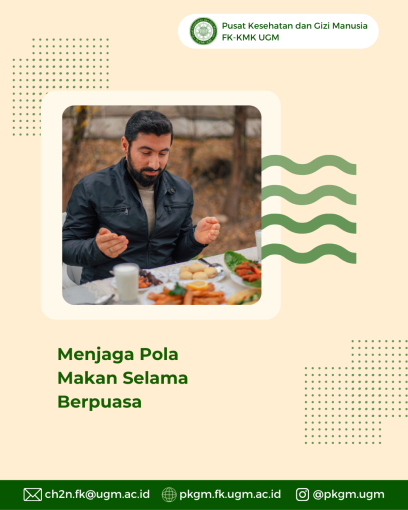
The food pattern during fasting is certainly changing. The changes occur when food consumption is limited so that the frequency of eating and the amount of food consumed are more limited. In general, people consume a portion of food three times a day but during fasting it changes to two times a day. Although eating patterns change during fasting, people must maintain optimal and balanced nutritional intake so that their body condition remains healthy and can undergo fasting properly. Therefore, the foods fulfillment with carbohydrates, fiber, vitamins and minerals, fats, and proteins must be considered accordingly.
Several things need to be considered in implementing a healthy diet while fasting. Three tips for maintaining a healthy diet during fasting are:
- Limit Salty Foods Consumption During Suhoor
Consuming salty foods will increase the intake of sodium that enters the body. It can increase urination after consuming drinks during the suhoor (Juraschek et.al., 2020). In addition, it also causes dry mouth and thirst. It is caused when the body improves the ratio of sodium and fluid balance to respond to the sodium increase (Agócs et al., 2020). Therefore, try to limit salt consumption or other high-sodium foods such as sauces, soy sauce, and canned foods during the suhoor.
- Consume Complex Carbohydrates and High Fiber
Consuming food sources of complex carbohydrates and high fiber are recommended at suhoor. Foods such as sweet potatoes, corn, cassava, oatmeal, whole wheat bread, and brown rice will provide a full effect for more than 6 hours. It happens because fiber can slow down the gastric emptying process, so that food absorption takes longer (Akbar et al., 2021). In addition, consuming enough fiber can also maintain a healthy digestive tract and prevent constipation (McRorie et al., 2016).
- Eat Sufficiently and Limit Sweet Foods During Iftar
When breaking the fast, you should consume food gradually. Avoid consuming heavy food immediately, because it can put an extra burden on digestion (Sanvictores et al., 2021). In addition, directly consuming a lot of food can make the stomach feel tight. Therefore, eat gradually, starting with water, then a little sweet food, and main food after an interval of half or an hour are recommended. When breaking the fast, it is also necessary to pay attention to the consumption of sweet foods, but people often consume drinks with high sugar and sweet foods when breaking the fast. Sweet foods have benefits in increasing low blood sugar levels while fasting. However, you need to be careful not to consume excess sugar.
References:
Akbar A, Shreenath AP. High Fiber Diet. [Updated 2021 May 9]. In: StatPearls [Internet]. Treasure Island (FL): StatPearls Publishing; 2022 Jan-. Available from: https://www.ncbi.nlm.nih.gov/books/NBK559033/
Agócs R, Sugár D, Szabó AJ. Is too much salt harmful? Yes. Pediatr Nephrol. 2020 Sep;35(9):1777-1785. doi: 10.1007/s00467-019-04387-4. Epub 2019 Nov 28. PMID: 31781959; PMCID: PMC7384997.
Juraschek SP, Miller ER 3rd, Chang AR, Anderson CAM, Hall JE, Appel LJ. Effects of Sodium Reduction on Energy, Metabolism, Weight, Thirst, and Urine Volume: Results From the DASH (Dietary Approaches to Stop Hypertension)-Sodium Trial. Hypertension. 2020 Mar;75(3):723-729. doi: 10.1161/HYPERTENSIONAHA.119.13932. Epub 2020 Jan 20. PMID: 31957521; PMCID: PMC7278848.
McRorie JW Jr, McKeown NM. Understanding the Physics of Functional Fibers in the Gastrointestinal Tract: An Evidence-Based Approach to Resolving Enduring Misconceptions about Insoluble and Soluble Fiber. J Acad Nutr Diet. 2017 Feb;117(2):251-264. doi: 10.1016/j.jand.2016.09.021. Epub 2016 Nov 15. PMID: 27863994.
Sanvictores T, Casale J, Huecker MR. Physiology, Fasting. [Updated 2021 Jul 26]. In: StatPearls [Internet]. Treasure Island (FL): StatPearls Publishing; 2022 Jan-. Available from: https://www.ncbi.nlm.nih.gov/books/NBK534877/
